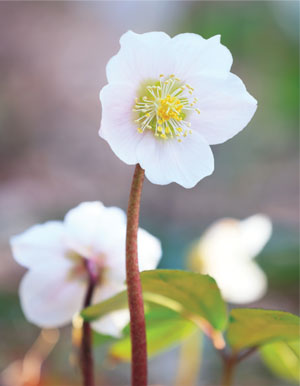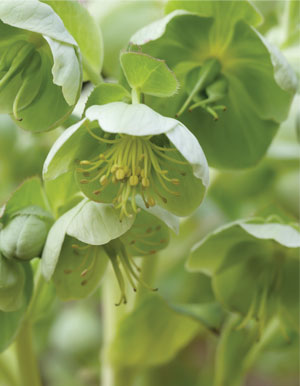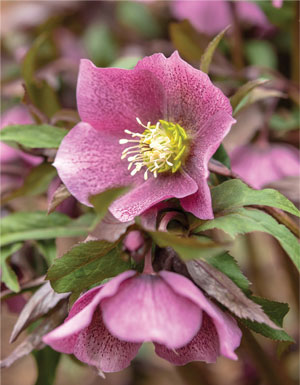HELLEBORES

THE STAR OF THE WINTER GARDEN
The list of recommendations in favor of hellebores is long. These shade-loving evergreen perennials bloom in winter and are available in an array of colors that deepen over the duration of their blooming period, which can last up to 10 weeks or more. Hellebores are low maintenance, unappealing to deer and other critters that like to nibble on your garden plants, and are susceptible to few pests and diseases. They are sometimes described as “the perfect plant,” so it’s little wonder they are so popular among gardeners.
Choose your favorite
When it comes to hellebores you have several options:
Then there is the light green, January-blooming, Stinking Hellebore. Despite its unfortunate name, the stinking hellebore only gives off its aroma when the foliage is cut or crushed.
The anatomy of a hellebore 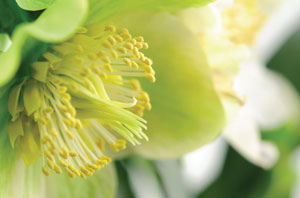 The colorful portion of hellebores are actually the sepal. On other flowers, the sepals are green and leaflike, protecting the petals from just underneath. On hellebores, the petals are actually very small structures that surround the stamens, so it’s really the sepals that provide the color we so appreciate. And those colors come in shades of white, yellows, greens, pinks and purples that range from pastels to dark-as-night almost black.
The colorful portion of hellebores are actually the sepal. On other flowers, the sepals are green and leaflike, protecting the petals from just underneath. On hellebores, the petals are actually very small structures that surround the stamens, so it’s really the sepals that provide the color we so appreciate. And those colors come in shades of white, yellows, greens, pinks and purples that range from pastels to dark-as-night almost black.
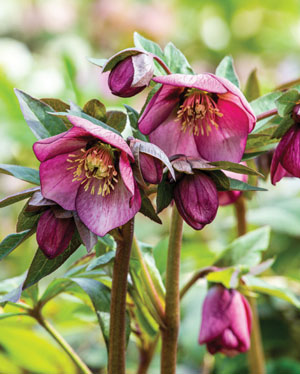 There is a great deal of variety to the sepals – they can be a single or double layer, with or without picotee edges (that are a different color from the rest of the flower) and/or veining. The centers can be a contrasting darker color or spotted or have an anemone flower. They tend to face downward, making them great to plant on sloped areas, although some newer cultivars face upwards. Lenten roses can be started from seed, but no two derived from a seed strain are the same. The best way to ensure you are getting the hellebore you really desire is to buy it while in bloom.
There is a great deal of variety to the sepals – they can be a single or double layer, with or without picotee edges (that are a different color from the rest of the flower) and/or veining. The centers can be a contrasting darker color or spotted or have an anemone flower. They tend to face downward, making them great to plant on sloped areas, although some newer cultivars face upwards. Lenten roses can be started from seed, but no two derived from a seed strain are the same. The best way to ensure you are getting the hellebore you really desire is to buy it while in bloom.
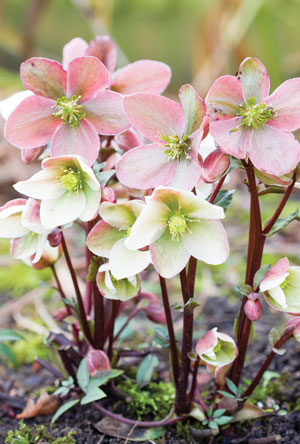 How to plant
How to plant
Hellebores can be planted in the fall through the spring. They like well drained, slightly acidic soil. Similar to peonies, hellebores don’t like to be planted too deeply or mulched too heavily. They should be given about 15 inches of space around them. Hellebores will spread, albeit slowly.
They are the sort of plant that sleeps, creeps and then leaps, meaning, the first year, it focuses on establishing roots; the second year, they get a little bigger; and then the third year, they will start to take off. This slowness factors into their price, as they tend to run from $15 and up for a single plant.
As they begin to flower, they will start producing small seedlings around the main plant. These seedlings can be moved, either into pots or into their own spots, where they will slowly grow into larger hellebores, taking about three years (sometimes longer) to begin blooming. Larger hellebores can be split in both spring or fall. However, hellebores dislike being moved, so cooler fall days seem to be a better time to rearrange them. They prefer shaded areas, but not too densely shaded – some morning sun or dappled afternoon sunlight suits them well.
The thick, waxy leaves of hellebores will start turning brown and wilted just as new growth appears in winter. This is a great time to trim them back to the base of the stalk, which gives more air and light to the flowers. Their leaves can cause mild irritation (they contain some toxins, so do keep them away from children and pets), so you’ll want to wear gloves when cutting back. Once they are finished blooming, you can remove the stems as well. Beyond that, hellebores need little maintenance. They will take a light fertilizing in fall, but it’s not necessary.
Hellebores can handle droughts, bouncing back with just a little watering. Even when flattened by ice and snow, hellebores will pop right back up with the first warm rays of sunshine. They grow marvelously in wooded gardens where they contrast with ferns and coral bells. With all these fabulous attributes, it’s easy to see why they are so beloved among gardeners. Although undoubtably, the biggest reason why gardeners love them so is that they are the harbingers of what’s to come: the first signs of life in the garden for the new year. They are the star of winter and rightfully so. ✦
Christmas Rose, evergreen perennials, greens, Hellebores, Lenten Rose, pinks, purples, sepal, Stinking Hellebore, white, yellows
